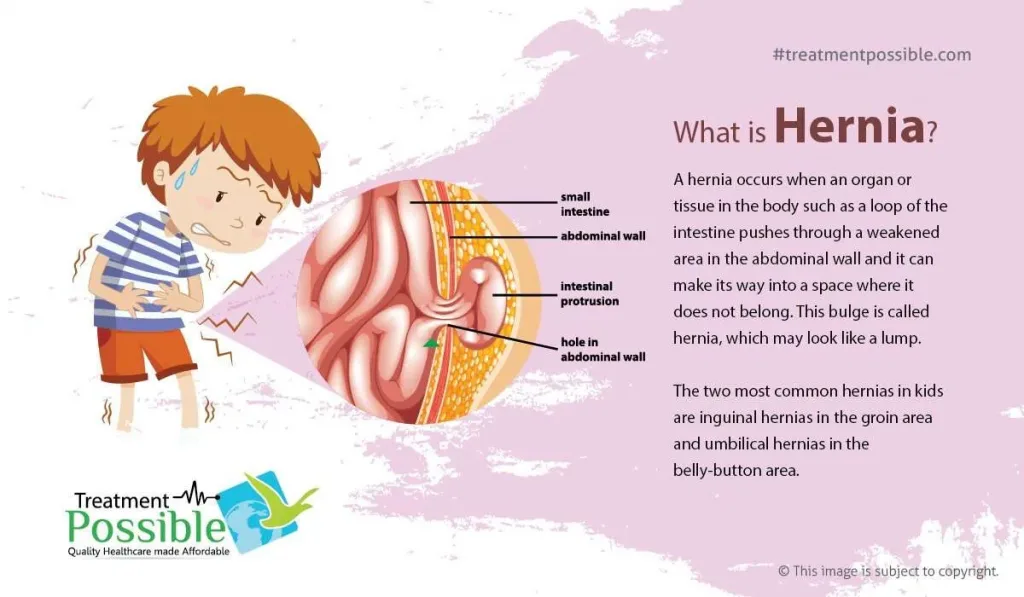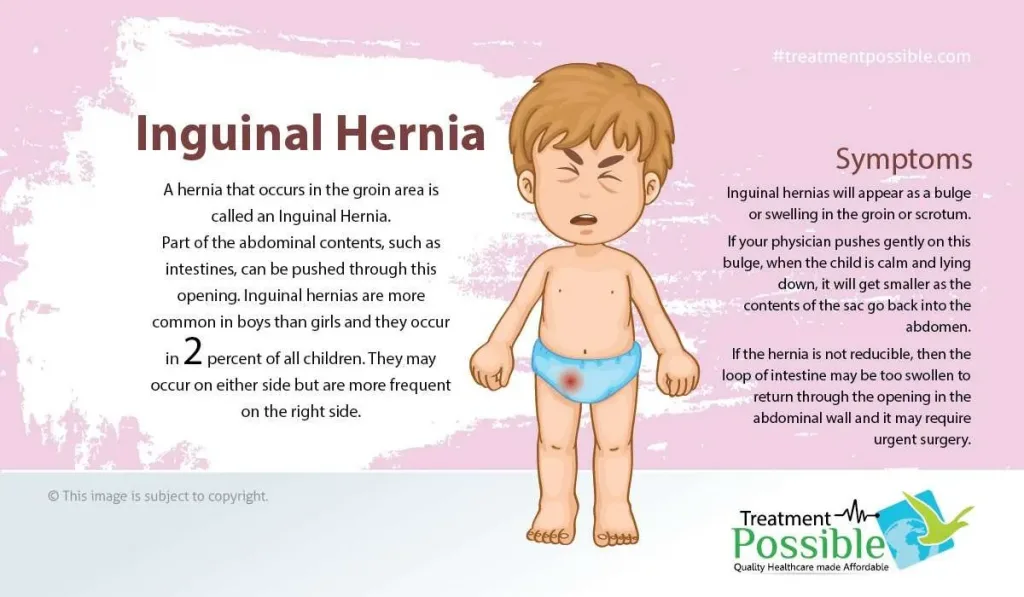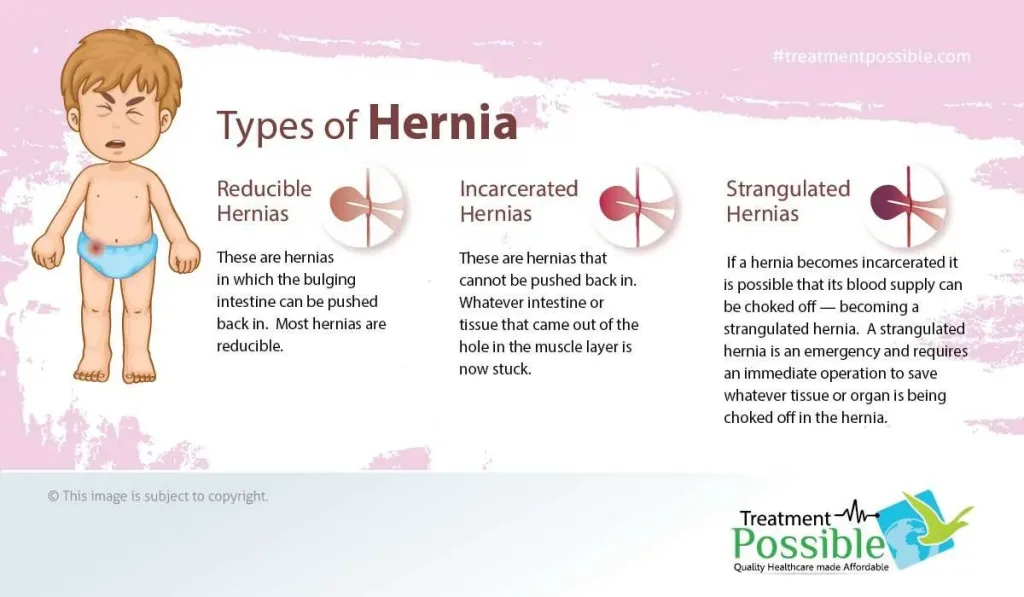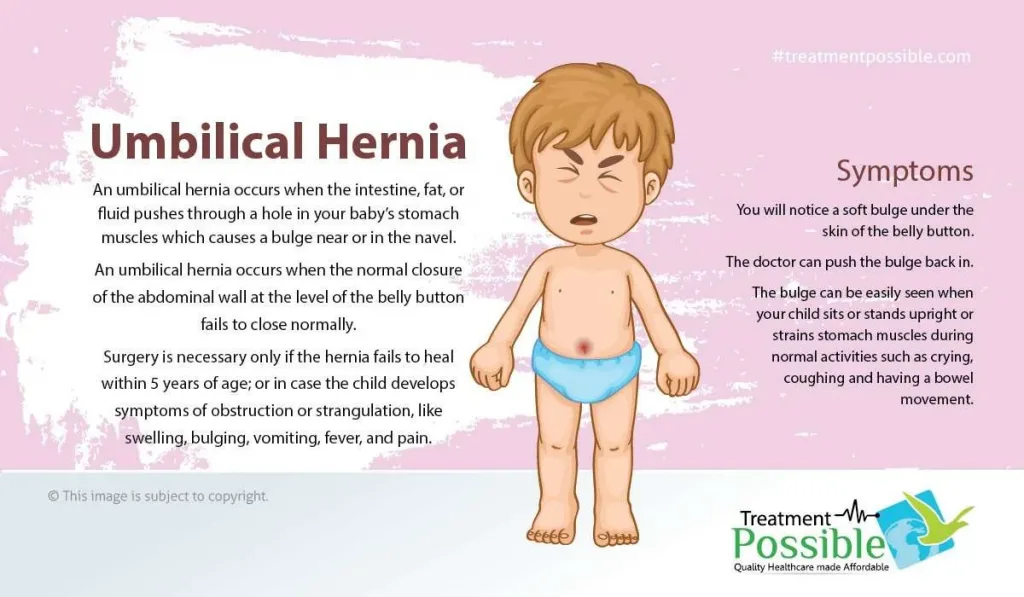Pediatric Hernia Treatment
What is a Hernia?
A hernia occurs when an organ or tissue in the body such as a loop of the intestine pushes through a weakened area in the abdominal wall and it can make its way into a space where it does not belong. This bulge is called hernia, and hernia Treatment is required for the lump. The two most common hernias in kids are inguinal hernias in the groin area and umbilical hernias in the belly-button area.

What is an Inguinal Hernia?
A hernia that occurs in the groin area is called an inguinal area. Part of the abdominal contents, such as intestines, can be pushed through this opening. Inguinal hernias are more common in boys than girls and they occur in 2 percent of all children. They may occur on either side but are more frequent on the right side.
What Causes an Inguinal Hernia?
Some factors that place children at higher risk for inguinal hernias are as follows:
- prematurity
- undescended testicles
- a family history of hernias
- cystic fibrosis
- developmental hip dysplasia
- urethral abnormalities
Although girls do not have testicles, they have an inguinal canal, so they can develop hernias as well. In some cases, the loop of the intestine which protrudes through a hernia may get stuck and they cannot return to the abdominal cavity. If the intestinal loop cannot be gently pushed back into the abdominal cavity, then that section of the intestine may lose its blood supply. Good blood supply is necessary for the intestine to stay healthy and function properly.
Want more clarification about medical expense & treatment plan?
Plan Your pediatric hernia treatment In India
What are the Symptoms of an Inguinal Hernia?
Inguinal hernias will appear as a bulge or swelling in the groin or scrotum. The swelling will be more noticeable when the baby cries and gets smaller or goes away when the baby relaxes. If your physician pushes gently on this bulge, when the child is calm and lying down, it will get smaller as the contents of the sac go back into the abdomen.
If the hernia is not reducible, then the loop of intestine may be too swollen to return through the opening in the abdominal wall and it may require urgent surgery.

How are Inguinal Hernia Diagnosed?
Most hernias are discovered by seeing or feeling the bulge. Parents or caregivers might be the first to notice although many times it is the pediatrician or other primary care provider who will find the hernia. In older children, the patient may be the first person to know that something is not quite right. When a hernia is suspected, the patient is referred to a surgeon to confirm the diagnosis and to discuss management plans with the family.
What are the Types of Hernia?
The types of Hernia fall into three categories.
- Reducible Hernias: These are hernias in which the bulging intestine can be pushed back in. Most hernias are reducible. One can often feel or hear a “squish” as the hernia is reduced (pushed back in). This feeling and sound is the actual intestine being pushed back through the hole in the muscle layer. Many hernias that are pushed back in pop right back out when one let’s go. This is especially true if the child is crying. Although the hernia won’t stay “in” or the bulge will not disappear, this is still considered a reducible hernia because it is possible to compress it. Reducible hernias generally don’t cause a patient much pain, but these types of hernias can be mildly uncomfortable at times.
- Incarcerated Hernias: These are hernias that cannot be pushed back in. Whatever intestine or tissue that came out of the hole in the muscle layer is now stuck. Incarcerated hernias are worrisome since it places the child at risk for having a strangulated hernia (see below). A child with an incarcerated hernia may complain of pain in the area. The bulge may be tender to the touch and there may be areas of swelling or redness around the bulge. The child may also experience vomiting or pain in the abdomen (tummy). If the child has an incarcerated hernia, he or she needs to see a doctor right away. Sometimes a doctor can push the hernia back in and relieve the incarceration; otherwise, the child may need an operation right away.
- Strangulated Hernias: If a hernia becomes incarcerated it is possible that its blood supply can be choked off — becoming a strangulated hernia. A strangulated hernia is an emergency and requires an immediate operation to save whatever tissue or organ is being choked off in the hernia. Patients have the potential to become ill as a result of the strangulated hernia.
Since inguinal hernias do not close on their own, they should be repaired. Some children’s may have health conditions which make surgery risky, but generally, hernia repair is recommended for all. The main reason that hernias are fixed is to prevent the problems that can arise from incarceration or strangulation of the hernia.

Inguinal Hernia Treatment:
During the initial meeting with the surgeon, he or she will review the child’s health, confirm the presence of a hernia, and determine if any additional testing is necessary before the repair. The surgeon will review the risks, benefits, alternatives, outcomes and complications of the various treatment options with the patient and family. If the patient requires surgery, it can be scheduled by appointment. In children, these operations are performed under general anesthesia and are generally done as an outpatient procedure, meaning the patient comes in and goes home on the same day. After hernia surgery, there will be a measure of pain. Many times this is controlled by medication.
What are the Different Types of Operations for the Hernia Treatment?
There are three different approaches to hernia treatment.
- Open repair – This involves making an incision just below the beltline and dissecting down to the hole in the muscle layer. This hernia is closed with stitches. The deeper tissues and skin are then sewn together with dissolvable sutures that are hidden under the skin so that there are no stitches to be removed. In teenagers, it is sometimes necessary to use a patch to help repair the hernia.
- Open repair with laparoscopic exploration – This is the same as the open repair except that before closing the hernia hole, a small camera (about 3 mm in diameter) is passed into the abdomen to examine the opposite groin from the inside. The surgeon will recommend this laparoscopic exploration in certain circumstances to rule out a potential hernia on the opposite side. If a hernia is detected, a matching incision is made on the opposite side to allow repair of the second hernia.
- Laparoscopic repair – In this approach the hernia is closed using laparoscopic techniques. A 3-mm or 5-mm camera is inserted through the belly button and additional instruments are introduced through needle holes to perform the hernia closure. There several different laparoscopic hernia repair techniques in children (eversion technique, intracorporeal suturing technique, single stitch technique) that a surgeon can use depending upon the particular patient.
What is an Umbilical Hernia?
An umbilical hernia occurs when the intestine, fat, or fluid pushes through a hole in your baby’s stomach muscles which causes a bulge near or in the navel. It appears as if your child’s navel is swollen.
Many children have an umbilical hernia at birth. The hernia usually is not painful or dangerous, and it often closes on its own without treatment, even the larger ones tend to close up on their own within 2 years of age. That is why the doctor advises to wait and watch for this kind of hernia for infants rather than operating. Surgery is necessary only if the hernia fails to heal within 5 years of age; or in case the child develops symptoms of obstruction or strangulation, like swelling, bulging, vomiting, fever, and pain.
What Causes an Umbilical Hernia?
An umbilical hernia occurs when the normal closure of the abdominal wall at the level of the belly button fails to close normally. This allows either tissue or fluid to enter into the protruding sac.
What are the Symptoms of an Umbilical Hernia?
An umbilical hernia can be seen after the umbilical cord stump falls off, within a few weeks after birth. But some children don’t get a hernia until they’re a little older. When a child has an umbilical hernia:
- You will notice a soft bulge under the skin of the belly button.
- The doctor can push the bulge back in.
- The bulge can be easily seen when your child sits or stands upright or strains stomach muscles during normal activities such as crying, coughing and having a bowel movement.
- Umbilical hernias can vary in size. They are rarely bigger than about 2.5 cm (1 in.) across but most children do not feel the pain from the hernia. You need to consult your doctor if your child is vomiting, has pain, or has a swollen belly.

How is an Umbilical Hernia Diagnosed?
Doctors can tell whether a child has an umbilical hernia by how the belly appears. If your child has a hernia, your doctor will check the size and shape and see whether the hernia can be pushed back in. The doctor will need to check your child regularly to see if the hernia has begun to close or not.
What are the Umbilical Hernia Treatment?
Umbilical hernias will naturally close on their own before a baby is 1 year old. If a hernia has not closed by the time your child is 5 years old, your child will probably need surgery to close it. Your child will need surgery before the age of 5 if:
- The hernia is large and has not shown any signs of closing by age 2.
- The way the hernia looks bothers you or your child.
If your child has pain, a swollen belly, or other signs that a part of the intestine is trapped in the hernia (incarcerated hernia), surgery will be needed immediately but this is a rare case.
Hernia treatment in kids is usually is an outpatient procedure, which means that your child can go home the same day the surgery is done. But some young infants need to be kept in the hospital overnight for observation. The period of recovery for kids is short; some can resume normal activities within 7 days after surgery, with the doctor’s approval. Until then, kids should avoid strenuous activity such as bicycle riding and tree climbing.
Complications from umbilical hernia Treatment are rare. In case you notice any signs of problems after the surgery, such as bleeding, swelling, or fever, consult your doctor and be sure to do all the follow-up examinations so that the doctor can make sure that your child is healing well.
Care at Treatment Possible:
Treatment Possible is associated with the Best Hernia Surgeon who are experienced in operating complex cases and ensure the highest success rate. We only work with Best Hospital for Hernia Surgery.
Our understanding of the Indian Healthcare market and our valued relation with Best Hospital for Hernia Surgery enables us to maintain the cost that are reasonable, affordable and transparent. Hernia Treatment Cost in India through Treatment Possible can be 10-20% lower than similar companies in India and 50-60% cheaper than in other countries.
You can also send your medical reports for Hernia surgery to care@treatmentpossible.com for free opinions and suggestions from The Best Hernia Specialist with the hassle-free setup of post-operative recovery care, medical travel & stay during the Medical treatment. No matter what the health condition, you always get good healthcare options and cost advantage from Treatment Possible.
